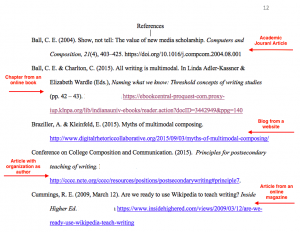12.7 APA Citations: References
Melanie Gagich
APA is a common documentation style used in the social sciences (e.g., psychology, sociology, education, criminology), business, nursing, linguistics, and composition. While the style, organization, and formatting of APA differ from MLA, similarities between the two styles remain. For example, to avoid plagiarism, provide readers with important source-related information, and give credit where credit is due, you must include bibliographic information at the end of the document (the Reference page) and in-text citations in the form of signal phrases and/or parenthetical citations. You should also double-space the entire document, use Times New Roman, 12-point font, and use 1-inch margins on all sides.
The remainder of this section provides basic information pertaining to creating the Reference page. Information about formatting your paper and/or incorporating APA headings can be found at the OWL of Purdue.
Reference Page Entries
- Every source that you quote, paraphrase, or summarize in an essay must be included in your Reference page
- The Reference page should appear on its own page. It should include the header (i.e., abbreviated title with the page number in the right-hand corner).
- At the start of your list, at the top margin of the page, center the word “References.” Do not bold, italicize, or use quotation marks. Do not change the font, font size, or color
- Reference page entries are in the same font and double spacing as the rest of the paper.
- Like MLA Work Cited pages, Reference page entries use hanging (also known as reverse) indentation, in which the first line of an entry is not indented, but all successive lines are indented, by .5″.
- Sources need to be listed in alphabetical order by the first letter in each entry.
-
- If you have a source with no author, then that source will be alphabetized according to the first letter of its title
- The entries will not be numbered or presented as a series of bulleted points.
Examples of Reference Page Entries
Formatting an Article from an Academic Journal with DOI
Author’s last name, first initial. middle initial. (Year, Month Date Published). Title of the article. Title of the Academic Journal, Volume # (Issue #), page numbers, DOI.
Example of an Article from an Academic Journal with DOI
Werner, C. L. (2015). Speaking of composing (frameworks): New media discussions, 2000–2010. Computers and Composition, 37, 55-72. http://dx.doi.org/10.1016/j.compcom.2015/06.005
Formatting an Article from an Academic Journal with No DOI
Author’s last name, first initial. middle initial. (Year, Month Date Published). Title of the article. Title of the Academic Journal, Volume # (Issue #), page numbers, URL.
Example of an Article from an Academic Journal with No DOI
Yancey, K. B. (2004). Made not only in words: Composition in a new key. College Composition and Communication, 56(2), 297-328. http://www.jstor.org/stable/4140651
Formatting an Article from an Online Magazine
Author, A. A., & Author, B. B. (Date of publication). Title of article. Title of Online Periodical, volume number(issue number if available).
https://www.someaddress.com/full/url/
Example of an Article from an Online Magazine
Wong, A. (2015, April). Digital natives, yet strangers to the web. The Atlantic. https://www.theatlantic.com/education/archive/2015/04/digital-natives-yet-strangers-to-the-web/390990/
Formatting an Article from a Website with an Author
Last, F. M. (Year, Month Date Published). Article title. URL.
Example of an Article from a Website with an Author
Braziller, A. & Kleinfeld, E. (2015). Myths of multimodal composing. http://www.digitalrhetoriccollaborative.org/2015/09/03/myths-of-multimodal-composing/
Example with an Organization as Author
National Council of Teachers of English. (2005, November). Position statement on multimodal literacies. http://www.ncte.org/positions/statements/multimodalliteracies
Formatting an Article from a Website with No Author
Title. (Year, Month Date Published). URL.
Example of an Article from a Website with No Author
Mobile campus laptop loan program (2019). https://www.csuohio.edu/services-for-students/mobile-campus
What Is the DOI?
DOI stands for “digital object identifier,” and it helps categorize scholarly articles. However, not all scholarly articles will have a DOI. If that is the case, then you should provide the URL where you retrieved the article.
Sample Reference Page


